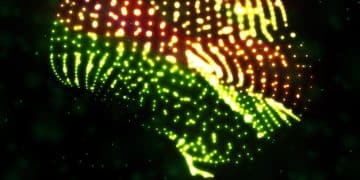Optimize Focus: Understanding and Managing Blue Light’s Impact

The Impact of Blue Light on Focus: How to Optimize Your Screen Settings involves understanding how blue light affects concentration and implementing strategies like using blue light filters, adjusting screen brightness, and taking regular breaks to mitigate its negative effects and enhance focus.
In today’s digital age, we spend countless hours glued to screens, from smartphones to computers. But have you ever considered the impact of blue light on focus: how to optimize your screen settings could be a game-changer for your concentration and productivity?
Understanding Blue Light and Its Sources
Blue light, a high-energy visible (HEV) light, is emitted by digital screens and fluorescent and LED lighting. While natural blue light from the sun is essential for regulating our sleep-wake cycle, artificial blue light exposure, especially in the evening, can disrupt our circadian rhythm and impact our ability to focus.
What is Blue Light?
Blue light is a range of the visible light spectrum with a short wavelength and high energy. It’s naturally present in sunlight, helping us stay awake and alert during the day.
Common Sources of Blue Light
- Digital Screens: Smartphones, tablets, laptops, and TVs are major sources of artificial blue light.
- LED and Fluorescent Lights: Many modern light bulbs emit significant amounts of blue light.
- Sunlight: The most significant natural source of blue light; however, our bodies are adapted to handle this type of exposure.
The prevalence of these sources means we’re constantly exposed, which can lead to issues with focus and sleep.
The Impact of Blue Light on Focus and Concentration
The impact of blue light on your focus and concentration is primarily due to its disruptive effects on the sleep cycle. When you look at your glowing devices, your body is suppressing melatonin, the hormone that makes you sleepy. Less melatonin makes it harder to fall asleep, which in turn damages daytime focus.

Disruption of Circadian Rhythm
Blue light can interfere with the production of melatonin, a hormone that regulates sleep. This disruption can lead to insomnia, making it difficult to maintain focus and concentration during the day.
Effects on Eye Strain and Fatigue
Prolonged exposure to blue light can cause digital eye strain, characterized by dry eyes, blurred vision, and headaches. These symptoms can significantly impact focus and productivity.
The effects are more pronounced with extended screen use, especially close to bedtime. Over time, these seemingly minor disruptions compound, creating chronic issues with focus and overall well-being.
Optimizing Your Screen Settings to Reduce Blue Light Exposure
Optimizing screen settings is a powerful, simple step toward reducing blue light exposure. Smartphones, tablets, and computers alike have settings that allow you to filter out blue light in the evenings especially. Many digital interfaces let you schedule these settings to turn on and off automatically, to match the time of day.
Using Blue Light Filters
Most devices have built-in blue light filters that reduce the amount of blue light emitted from the screen. Activating this feature, especially in the evening, can help minimize its impact on sleep and focus.
Adjusting Screen Brightness
Lowering the brightness of your screen can also reduce blue light exposure. Adjust the brightness to a comfortable level that doesn’t strain your eyes, particularly in low-light environments.
Utilizing Dark Mode
Switching to dark mode can reduce the overall amount of light emitted by your screen, including blue light. This can be especially helpful for nighttime use, making it easier on your eyes and less disruptive to your sleep cycle.
These small adjustments can make a significant difference in your overall well-being. Experiment with each setting to find what works best for you and your environment.
The Role of Blue Light Blocking Glasses
Blue light blocking glasses have emerged as a popular tool for those seeking to minimize the negative effects of digital screens. But glasses can be expensive and not always practical for everyday wear. However, they are a scientifically designed tool for filtering out harmful light.

How Blue Light Blocking Glasses Work
These glasses have lenses that filter out or block blue light. They typically have an amber or yellow tint, which helps to neutralize the blue light emitted from digital screens.
Benefits of Wearing Blue Light Blocking Glasses
- Reduced Eye Strain: By filtering out blue light, these glasses can help reduce digital eye strain and fatigue.
- Improved Sleep: Wearing them in the evening can help regulate melatonin production and improve sleep quality.
- Enhanced Focus: By minimizing the disruptive effects of blue light, these glasses can contribute to better focus and concentration.
While glasses require more planning and expense, they could nonetheless be worth the expense if you spend hours in front of screens.
Lifestyle Adjustments to Minimize Blue Light Exposure
Lifestyle adjustments are often overlooked, but some of the most meaningful changes you can make involve simply stepping away from screens regularly. Other light sources can also have a positive impact, and good sleep hygiene plays a critical role in focus.
Taking Regular Breaks
The 20-20-20 rule is an easy way to encourage eye movement and relaxation. Every 20 minutes, look at something 20 feet away for 20 seconds. This can help reduce eye strain and improve focus.
Creating a Screen-Free Evening Routine
Avoid using digital devices at least one to two hours before bedtime. Engage in relaxing activities such as reading a book, taking a warm bath, or practicing meditation to prepare your mind for sleep.
Optimizing Your Sleep Environment
Ensure your bedroom is dark, quiet, and cool to promote restful sleep. Use blackout curtains, earplugs, or a white noise machine to minimize distractions.
These adjustments are not only simple, but they also improve overall health and mental well-being.
The Best Apps and Software for Managing Blue Light
Many apps and software programs have been designed to manage blue light settings automatically. It’s one of the most effective ways to reduce eye strain and improve your sleep while staying online.
F.lux
This is a free software application that automatically adjusts the color temperature of your screen based on the time of day, reducing blue light exposure in the evening.
Night Shift (iOS) and Night Mode (Android)
These built-in features on iOS and Android devices filter out blue light by shifting the display to warmer colors during specified hours.
Blue Light Filter Apps
There are numerous apps available on app stores that offer customizable blue light filtering options. These apps allow you to adjust the intensity of the filter and set schedules based on your preferences.
The range of options means you can tailor the filters and settings to your individual needs and preferences.
| Key Point | Brief Description |
|---|---|
| 💡 Blue Light Effects | Disrupts sleep, causes eye strain, and reduces focus. |
| 📱 Screen Optimization | Use filters, adjust brightness, and enable dark mode. |
| 👓 Blue Light Glasses | Block blue light, reduce eye strain, and improve sleep. |
| ⏰ Lifestyle Changes | Take breaks, create a screen-free routine, and optimize sleep. |
Frequently Asked Questions
▼
Blue light is a high-energy visible (HEV) light emitted from digital screens, LED and fluorescent lighting, and the sun. It is a range of the visible light spectrum with a short wavelength and high energy.
▼
Blue light disrupts the production of melatonin, a hormone that regulates sleep. This disruption can lead to insomnia and daytime fatigue, making it difficult to focus. Too much screen time throws off sleep cycles.
▼
Yes, blue light blocking glasses can reduce eye strain, improve sleep quality, and enhance focus by filtering out or blocking blue light. These glasses are an effective tool to safeguard your health.
▼
Use blue light filters, adjust screen brightness to a comfortable level, especially in low-light environments, and switch to dark mode to reduce overall light exposure. You can play around with each setting to find what works for you.
▼
Yes, apps like F.lux and built-in features such as Night Shift (iOS) and Night Mode (Android) can automatically adjust the color temperature of your screen based on the time of day, reducing blue light exposure.
Conclusion
Understanding the impact of blue light on focus: how to optimize your screen settings is crucial in today’s digital world. By making small adjustments to your screen settings, using blue light blocking glasses, and incorporating lifestyle changes, you can minimize its negative effects and improve your focus, sleep, and overall well-being.





